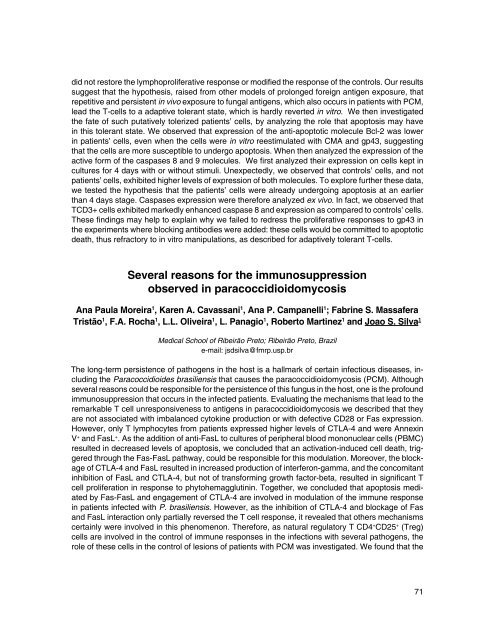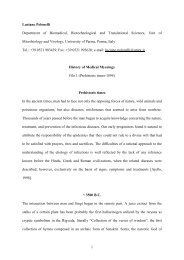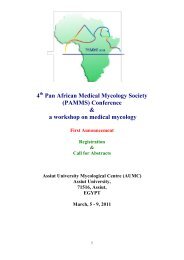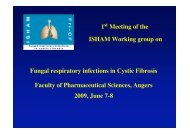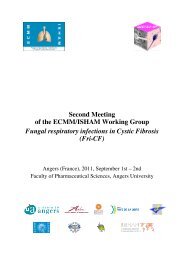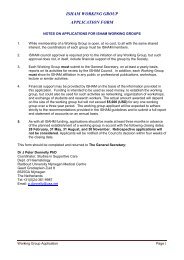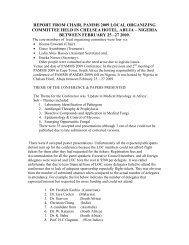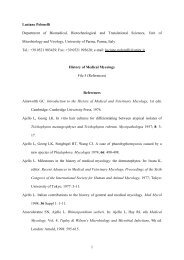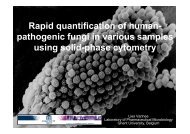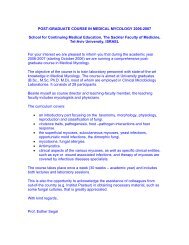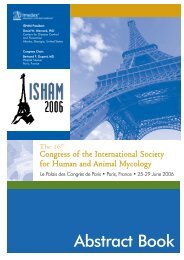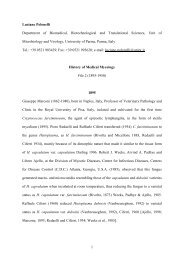Memoria CD.indd - ISHAM
Memoria CD.indd - ISHAM
Memoria CD.indd - ISHAM
You also want an ePaper? Increase the reach of your titles
YUMPU automatically turns print PDFs into web optimized ePapers that Google loves.
did not restore the lymphoproliferative response or modified the response of the controls. Our resultssuggest that the hypothesis, raised from other models of prolonged foreign antigen exposure, thatrepetitive and persistent in vivo exposure to fungal antigens, which also occurs in patients with PCM,lead the T-cells to a adaptive tolerant state, which is hardly reverted in vitro. We then investigatedthe fate of such putatively tolerized patients’ cells, by analyzing the role that apoptosis may havein this tolerant state. We observed that expression of the anti-apoptotic molecule Bcl-2 was lowerin patients’ cells, even when the cells were in vitro reestimulated with CMA and gp43, suggestingthat the cells are more susceptible to undergo apoptosis. When then analyzed the expression of theactive form of the caspases 8 and 9 molecules. We first analyzed their expression on cells kept incultures for 4 days with or without stimuli. Unexpectedly, we observed that controls’ cells, and notpatients’ cells, exhibited higher levels of expression of both molecules. To explore further these data,we tested the hypothesis that the patients’ cells were already undergoing apoptosis at an earlierthan 4 days stage. Caspases expression were therefore analyzed ex vivo. In fact, we observed thatT<strong>CD</strong>3+ cells exhibited markedly enhanced caspase 8 and expression as compared to controls’ cells.These findings may help to explain why we failed to redress the proliferative responses to gp43 inthe experiments where blocking antibodies were added: these cells would be committed to apoptoticdeath, thus refractory to in vitro manipulations, as described for adaptively tolerant T-cells.Several reasons for the immunosuppressionobserved in paracoccidioidomycosisAna Paula Moreira 1 , Karen A. Cavassani 1 , Ana P. Campanelli 1 ; Fabrine S. MassaferaTristão 1 , F.A. Rocha 1 , L.L. Oliveira 1 , L. Panagio 1 , Roberto Martinez 1 and Joao S. Silva 1Medical School of Ribeirão Preto; Ribeirão Preto, Brazile-mail: jsdsilva@fmrp.usp.brThe long-term persistence of pathogens in the host is a hallmark of certain infectious diseases, includingthe Paracoccidioides brasiliensis that causes the paracoccidioidomycosis (PCM). Althoughseveral reasons could be responsible for the persistence of this fungus in the host, one is the profoundimmunosuppression that occurs in the infected patients. Evaluating the mechanisms that lead to theremarkable T cell unresponsiveness to antigens in paracoccidioidomycosis we described that theyare not associated with imbalanced cytokine production or with defective <strong>CD</strong>28 or Fas expression.However, only T lymphocytes from patients expressed higher levels of CTLA-4 and were AnnexinV + and FasL + . As the addition of anti-FasL to cultures of peripheral blood mononuclear cells (PBMC)resulted in decreased levels of apoptosis, we concluded that an activation-induced cell death, triggeredthrough the Fas-FasL pathway, could be responsible for this modulation. Moreover, the blockageof CTLA-4 and FasL resulted in increased production of interferon-gamma, and the concomitantinhibition of FasL and CTLA-4, but not of transforming growth factor-beta, resulted in significant Tcell proliferation in response to phytohemagglutinin. Together, we concluded that apoptosis mediatedby Fas-FasL and engagement of CTLA-4 are involved in modulation of the immune responsein patients infected with P. brasiliensis. However, as the inhibition of CTLA-4 and blockage of Fasand FasL interaction only partially reversed the T cell response, it revealed that others mechanismscertainly were involved in this phenomenon. Therefore, as natural regulatory T <strong>CD</strong>4 + <strong>CD</strong>25 + (Treg)cells are involved in the control of immune responses in the infections with several pathogens, therole of these cells in the control of lesions of patients with PCM was investigated. We found that the71


